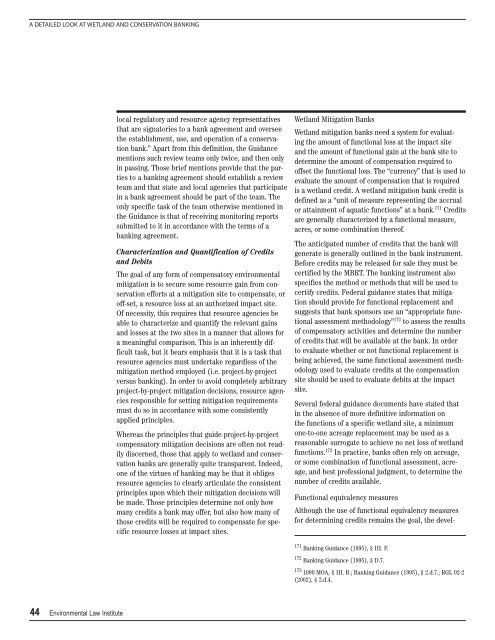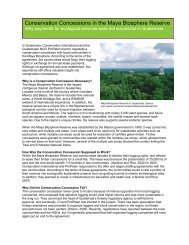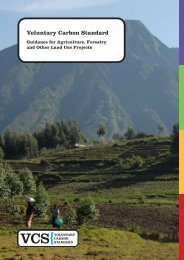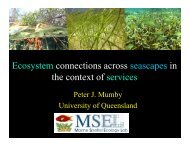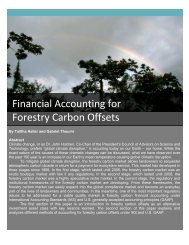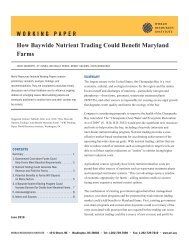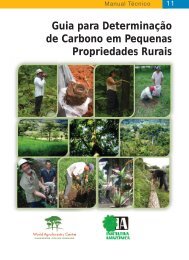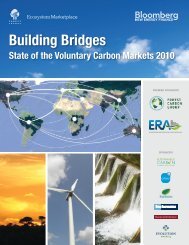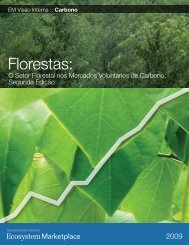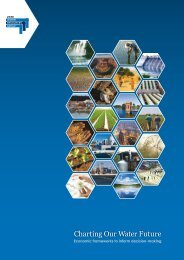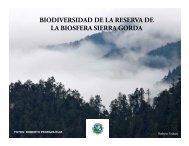Design of US Habitat Banking Systems to Support the Conservation ...
Design of US Habitat Banking Systems to Support the Conservation ...
Design of US Habitat Banking Systems to Support the Conservation ...
You also want an ePaper? Increase the reach of your titles
YUMPU automatically turns print PDFs into web optimized ePapers that Google loves.
A DETAILED LOOK AT WETLAND AND CONSERVATION BANKINGlocal regula<strong>to</strong>ry and resource agency representativesthat are signa<strong>to</strong>ries <strong>to</strong> a bank agreement and oversee<strong>the</strong> establishment, use, and operation <strong>of</strong> a conservationbank.” Apart from this definition, <strong>the</strong> Guidancementions such review teams only twice, and <strong>the</strong>n onlyin passing. Those brief mentions provide that <strong>the</strong> parties<strong>to</strong> a banking agreement should establish a reviewteam and that state and local agencies that participatein a bank agreement should be part <strong>of</strong> <strong>the</strong> team. Theonly specific task <strong>of</strong> <strong>the</strong> team o<strong>the</strong>rwise mentioned in<strong>the</strong> Guidance is that <strong>of</strong> receiving moni<strong>to</strong>ring reportssubmitted <strong>to</strong> it in accordance with <strong>the</strong> terms <strong>of</strong> abanking agreement.Characterization and Quantification <strong>of</strong> Creditsand DebitsThe goal <strong>of</strong> any form <strong>of</strong> compensa<strong>to</strong>ry environmentalmitigation is <strong>to</strong> secure some resource gain from conservationefforts at a mitigation site <strong>to</strong> compensate, or<strong>of</strong>f-set, a resource loss at an authorized impact site.Of necessity, this requires that resource agencies beable <strong>to</strong> characterize and quantify <strong>the</strong> relevant gainsand losses at <strong>the</strong> two sites in a manner that allows fora meaningful comparison. This is an inherently difficulttask, but it bears emphasis that it is a task thatresource agencies must undertake regardless <strong>of</strong> <strong>the</strong>mitigation method employed (i.e. project-by-projectversus banking). In order <strong>to</strong> avoid completely arbitraryproject-by-project mitigation decisions, resource agenciesresponsible for setting mitigation requirementsmust do so in accordance with some consistentlyapplied principles.Whereas <strong>the</strong> principles that guide project-by-projectcompensa<strong>to</strong>ry mitigation decisions are <strong>of</strong>ten not readilydiscerned, those that apply <strong>to</strong> wetland and conservationbanks are generally quite transparent. Indeed,one <strong>of</strong> <strong>the</strong> virtues <strong>of</strong> banking may be that it obligesresource agencies <strong>to</strong> clearly articulate <strong>the</strong> consistentprinciples upon which <strong>the</strong>ir mitigation decisions willbe made. Those principles determine not only howmany credits a bank may <strong>of</strong>fer, but also how many <strong>of</strong>those credits will be required <strong>to</strong> compensate for specificresource losses at impact sites.Wetland Mitigation BanksWetland mitigation banks need a system for evaluating<strong>the</strong> amount <strong>of</strong> functional loss at <strong>the</strong> impact siteand <strong>the</strong> amount <strong>of</strong> functional gain at <strong>the</strong> bank site <strong>to</strong>determine <strong>the</strong> amount <strong>of</strong> compensation required <strong>to</strong><strong>of</strong>fset <strong>the</strong> functional loss. The “currency” that is used <strong>to</strong>evaluate <strong>the</strong> amount <strong>of</strong> compensation that is requiredis a wetland credit. A wetland mitigation bank credit isdefined as a “unit <strong>of</strong> measure representing <strong>the</strong> accrualor attainment <strong>of</strong> aquatic functions” at a bank. 171 Creditsare generally characterized by a functional measure,acres, or some combination <strong>the</strong>re<strong>of</strong>.The anticipated number <strong>of</strong> credits that <strong>the</strong> bank willgenerate is generally outlined in <strong>the</strong> bank instrument.Before credits may be released for sale <strong>the</strong>y must becertified by <strong>the</strong> MBRT. The banking instrument alsospecifies <strong>the</strong> method or methods that will be used <strong>to</strong>certify credits. Federal guidance states that mitigationshould provide for functional replacement andsuggests that bank sponsors use an “appropriate functionalassessment methodology” 172 <strong>to</strong> assess <strong>the</strong> results<strong>of</strong> compensa<strong>to</strong>ry activities and determine <strong>the</strong> number<strong>of</strong> credits that will be available at <strong>the</strong> bank. In order<strong>to</strong> evaluate whe<strong>the</strong>r or not functional replacement isbeing achieved, <strong>the</strong> same functional assessment methodologyused <strong>to</strong> evaluate credits at <strong>the</strong> compensationsite should be used <strong>to</strong> evaluate debits at <strong>the</strong> impactsite.Several federal guidance documents have stated thatin <strong>the</strong> absence <strong>of</strong> more definitive information on<strong>the</strong> functions <strong>of</strong> a specific wetland site, a minimumone-<strong>to</strong>-one acreage replacement may be used as areasonable surrogate <strong>to</strong> achieve no net loss <strong>of</strong> wetlandfunctions. 173 In practice, banks <strong>of</strong>ten rely on acreage,or some combination <strong>of</strong> functional assessment, acreage,and best pr<strong>of</strong>essional judgment, <strong>to</strong> determine <strong>the</strong>number <strong>of</strong> credits available.Functional equivalency measuresAlthough <strong>the</strong> use <strong>of</strong> functional equivalency measuresfor determining credits remains <strong>the</strong> goal, <strong>the</strong> devel-171 <strong>Banking</strong> Guidance (1995), § III. F.172 <strong>Banking</strong> Guidance (1995), § D.7.173 1990 MOA, § III. B.; <strong>Banking</strong> Guidance (1995), § 2.d.7.; RGL 02-2(2002), § 2.d.4.44 Environmental Law Institute


